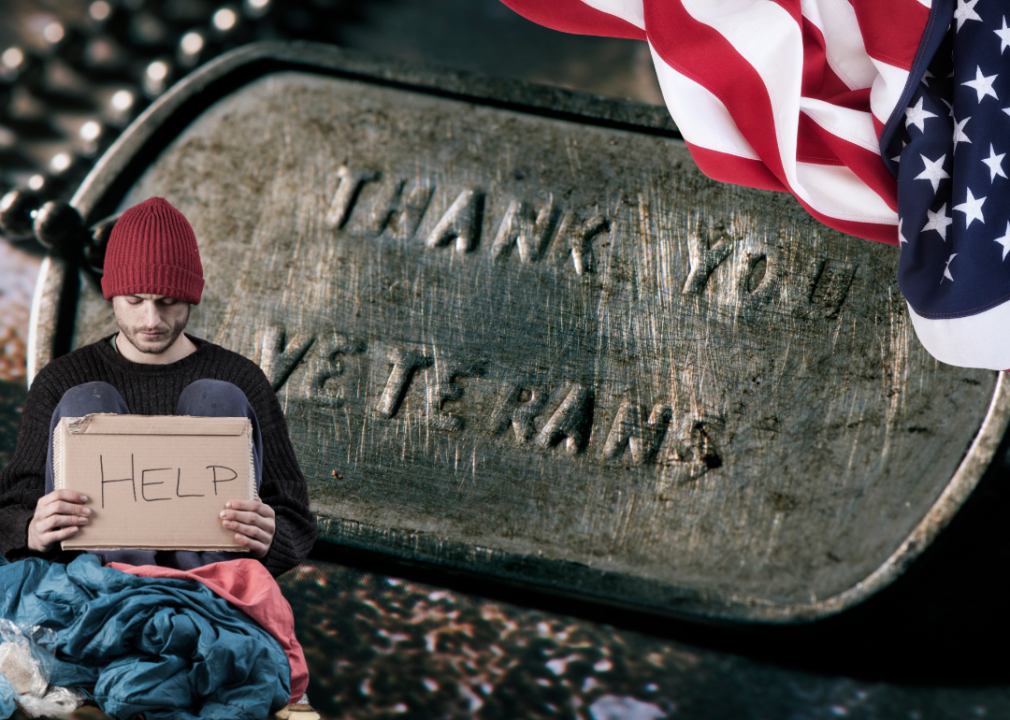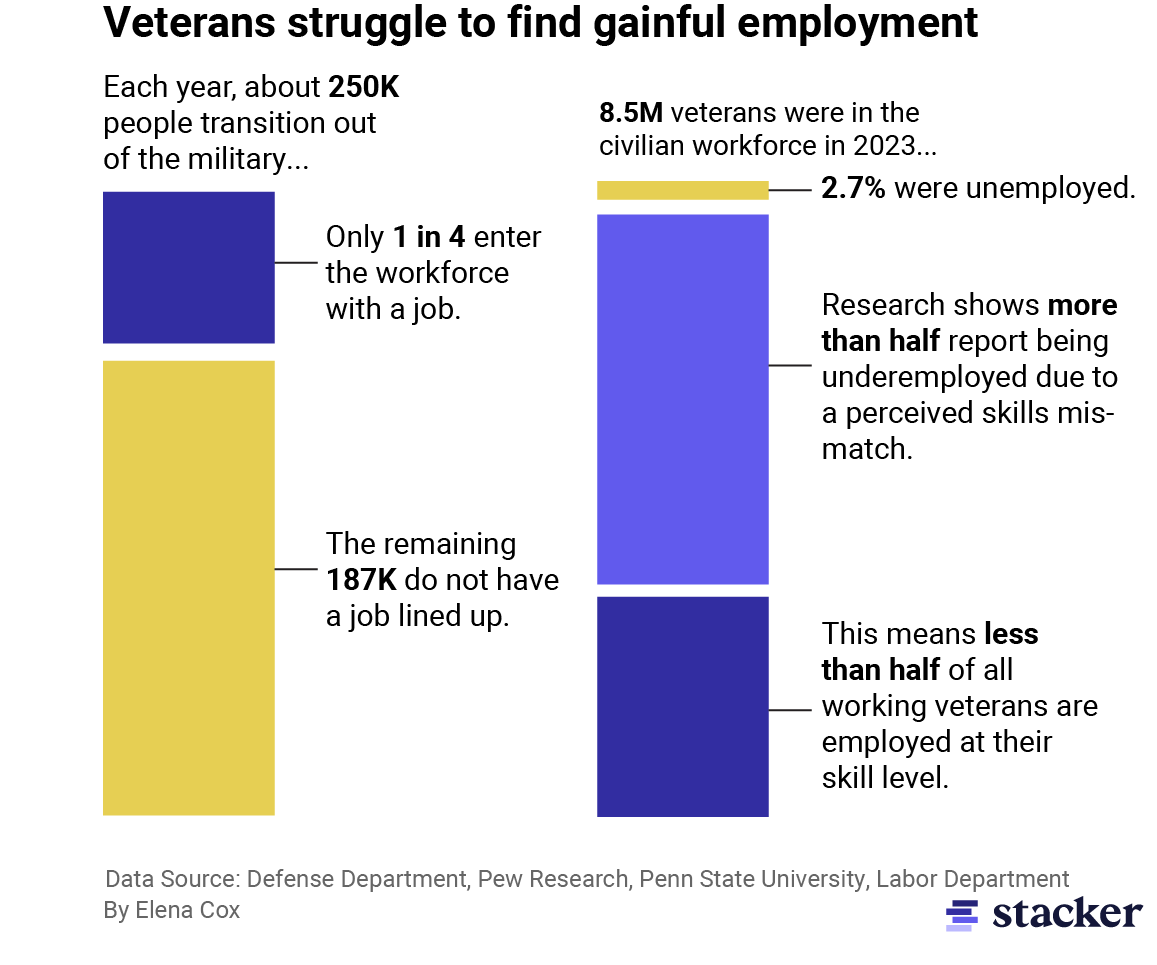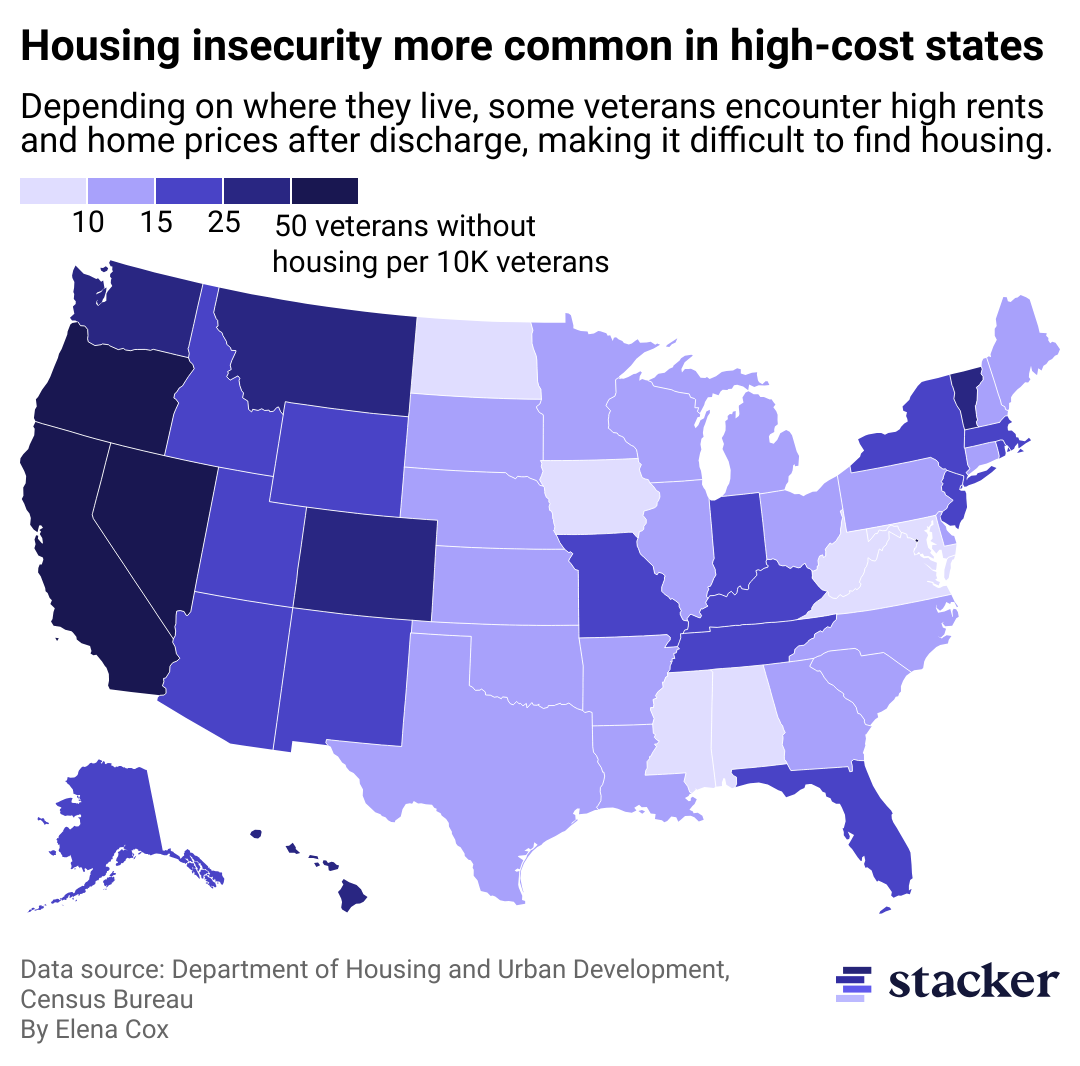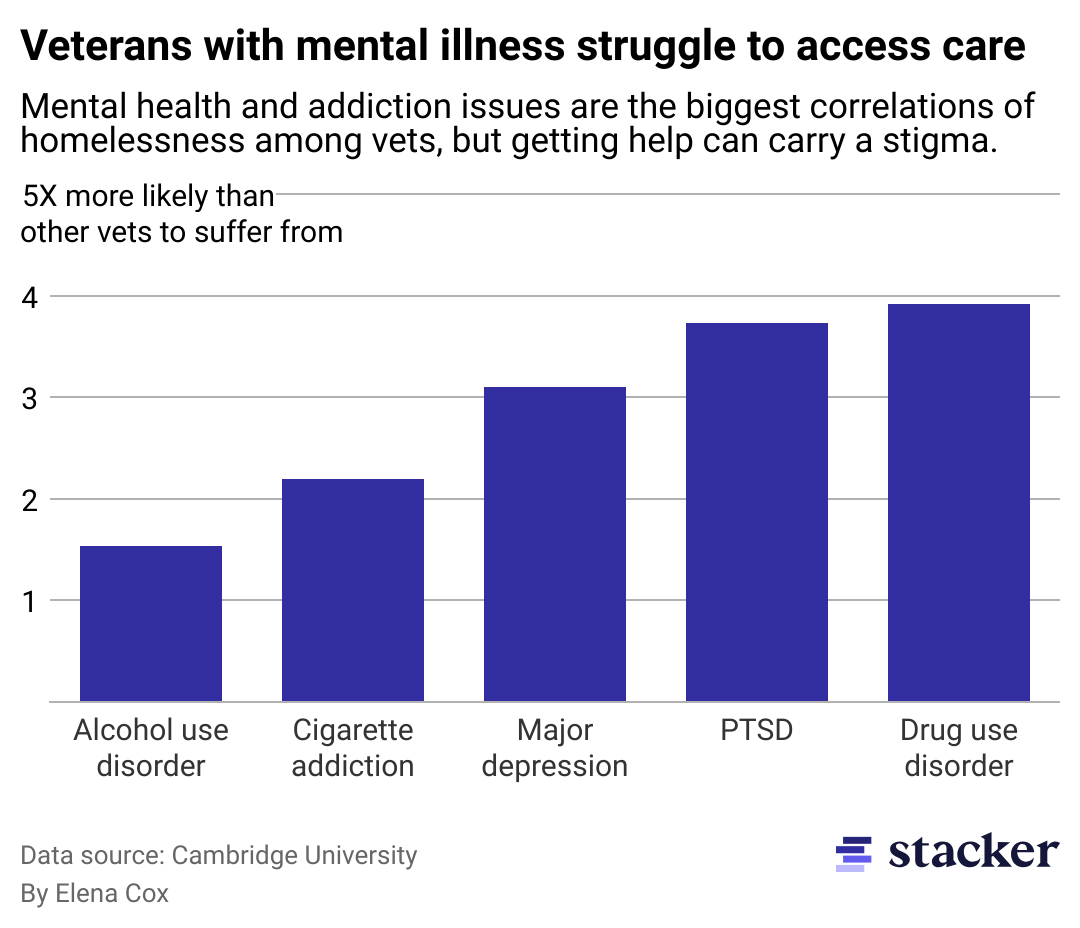Veteran homelessness is on the rise despite government efforts—here's how it happens

Photo illustration by Michael Flocker // Stacker // Canva
Veteran homelessness is on the rise despite government efforts—here’s how it happens
A man is seated against a backdrop of a military dog tag and an American flag.
Homelessness reached record levels in 2023, as rents and home prices continued to rise in most of the U.S. One group was particularly impacted: people who have served in the U.S. military.
“This time last year, we knew the nation was facing a deadly public health crisis,” Jeff Olivet, executive director of the U.S. Interagency Council on Homelessness, said in a statement about the 2023 numbers. He said the latest homelessness estimates from the Department of Housing and Urban Development “confirms the depth of the crisis.”
At least 35,000 veterans were experiencing homelessness in 2023, according to HUD. While that’s about half of what it was in 2009—when the organization began collecting data—things have plateaued in recent years despite active efforts to get that number to zero.
Although they make up just 6.6% of the total homeless population, veterans are more likely to be at risk of homelessness than Americans overall. Of every 10,000 Americans, 20 were experiencing homelessness. Of veterans living in the United States, that number jumps to 22, HUD data shows.
Complicated by bureaucracy, family dynamics, and prejudice, the path from serving in the military to homelessness is a long one. According to a 2022 study by Yale School of Medicine researchers, homelessness typically occurs within four years of leaving the military, as veterans must contend with the harsh reality of finding a job in a world where employers struggle to see how skills on the battlefield transfer to a corporate environment.
These days, veterans also deal with historically high rent and home prices, which causes many to rely on family generosity while figuring out a game plan.
Stacker examined academic studies, analyzed government data, and spoke with members of the Biden administration, experts, and former members of the armed forces to see the struggles members of the military face when leaving the armed forces.
![]()

Stacker
Veterans struggle to find a path forward
An infographic showing the difficulty of finding employment after leaving the military: 250,000 people transition out of the military each year, only 1 in 4 enter the workforce with a job and the remaining 187,000 do not have a job lined up. 8.5 million veterans were in the civilian workforce in 2023, 2.7% were unemployed. Research shows more than half report being underemployed due to a perceived skills mismatch. This means less than half of all working veterans are employed at their skill level.
The Department of Veterans Affairs offers transition assistance to the roughly 250,000 service members who leave each year. However, those programs can be burdensome and complex to navigate, especially for those who don’t have a plan for post-military life.
Only a small portion of veterans have jobs lined up when they leave, according to 2019 Pew Research. Many also choose to live with relatives until they get on their feet, which can be longer than anticipated. Some former service members are unsure what kind of career they’d like to pursue and may have to get further education or training, Carl Castro, director of the Military and Veteran Programs at the Suzanne Dworak-Peck School of Social Work at the University of Southern California, told Stacker.
“It takes years for that kind of transition,” Castro said.
Many have trouble finding a job after leaving the service, even if they are qualified. Some employers carry misconceptions about those who have served. A 2020 analysis from the journal Human Resource Management Review found that some veterans face hiring discrimination due to negative stereotypes that lead hiring managers to write them off as a poor culture fit.
Underemployment, or working low-wage jobs below their skill level, is also an issue. While the unemployment rate for veterans was 3% in March 2024, a study released by Penn State at the end of 2023 found three years after leaving the service, 61% of veterans said they were underemployed because of perceived skill mismatches.
This phenomenon can have long-term economic effects, and eventually, that frustration can boil over, strain relationships, and potentially lead to housing instability.
Working, especially a low-wage job, is not protection against homelessness. A 2021 study from the University of Chicago found half of people living in homeless shelters and 2 in 5 unsheltered people were employed, full or part-time.

Stacker
Some veterans struggle to find homes in their budget
A map showing the rate of veterans experiencing homelessness by U.S. state. Generally, states in the western half of the country have higher rates of veterans without housing, as do Alaska and Hawaii. States in the Midwest, South, and East Coast with the highest rates include Missouri, Indiana, Kentucky, Tennessee, Florida, New York, Vermont, Massachusetts, and New Jersey.
High rents make it difficult to save up, even when applying for a VA loan—a mortgage backed by the Department of Veterans Affairs that typically has more favorable terms.
While the VA does not require a downpayment, some lenders, who ultimately provide the loan, do. They’re not entirely risk-free either, and veterans can still lose their homes if they are unable to keep up with their mortgages.
In November 2023, the VA put a six-month pause on foreclosures when an NPR investigation found thousands of veterans were in danger of losing their homes after a COVID forbearance program ended.
Biden officials pointed to high rents and the end of COVID-era housing restrictions like eviction moratoriums to explain the spike in Americans experiencing homelessness. In the last year, homelessness rose 12%—to more than 650,000 people—the highest level since data began being collected in 2007.
Overall, more than half of people experiencing homelessness in 2023 live in states with high living costs. Most were in California, followed by New York and Florida. Western states, including Montana and Utah, experienced massive population growth during the pandemic, becoming hubs for remote workers who drove home prices and rents even further.

Stacker
Vets with mental health issues most at risk for homelessness
A bar chart showing that veterans experiencing homelessness are more likely to suffer from mental health and addiction issues.
For veterans, housing costs certainly play a role, but those who leave the military also face systemic barriers.
“It’s worrying there are people that continue to fall through the cracks,” said Jeanette Yih Harvie, a research associate at Syracuse University’s D’Aniello Institute for Veterans and Military Families.
Just under a quarter of adults experiencing homelessness have a severe mental illness, according to 2022 HUD survey data. They are also likely to have chronic illnesses but are unable to maintain preventative care, which only exacerbates these problems.
Veterans facing homelessness are more likely to have experienced trauma, either before or after joining the military, according to Yale researchers who analyzed the 2019-2020 National Health and Resilience in Veterans Study. Childhood trauma was among the most significant commonalities among vets who become homeless. Substance use disorder is also widespread and can indicate an undiagnosed mental illness.
Racial and ethnic disparities are at play, too. A 2023 study in the Journal of Psychiatric Research showed that Hispanic and Black veterans were more likely to screen positive for PTSD, and Hispanic veterans were more likely to report having suicidal ideation.
Overall, access to mental health care has improved in the last decade or so. In December 2023, the VA announced it would open nine additional counseling centers. However, the stigma of getting help remains, especially after years of being conditioned to be self-reliant and pull oneself up by their bootstraps.
That help, in the form of public policy, is slowly working to catch up to the need.
In 2023, the Biden administration invested millions into research programs and studies on suicide prevention by the VA office in addition to a proposed $16 billion to improve quality and lower-cost mental health care services for veterans. And, in February of this year, HUD and the VA announced they would give up to $14 million in vouchers to public housing agencies for veterans experiencing homelessness. The program would also offer case management and other services.
Still, with a culture that pushes people to keep going, it can be challenging for servicemembers to take advantage of these opportunities, Harvie said. “When you’ve been doing that for the last 15 or 20 years, it’s difficult to stop and say, ‘I’m the person that needs help.'”
Story editing by Kelly Glass. Copy editing by Kristen Wegrzyn.
